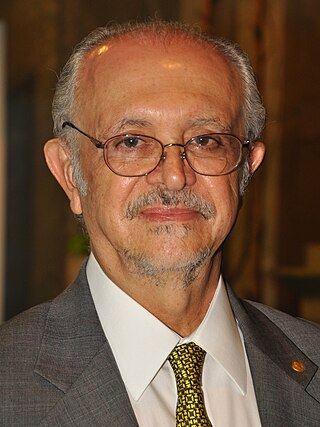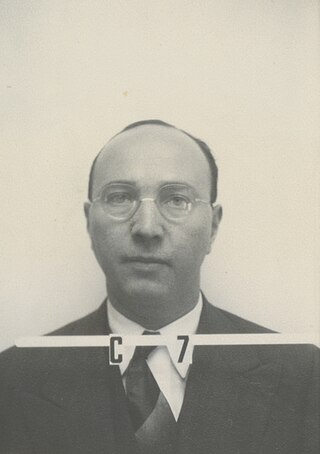Related Research Articles

Glenn Theodore Seaborg was an American chemist whose involvement in the synthesis, discovery and investigation of ten transuranium elements earned him a share of the 1951 Nobel Prize in Chemistry. His work in this area also led to his development of the actinide concept and the arrangement of the actinide series in the periodic table of the elements.

Ernest Orlando Lawrence was an American nuclear physicist and winner of the Nobel Prize in Physics in 1939 for his invention of the cyclotron. He is known for his work on uranium-isotope separation for the Manhattan Project, as well as for founding the Lawrence Berkeley National Laboratory and the Lawrence Livermore National Laboratory.

Willard Frank Libby was an American physical chemist noted for his role in the 1949 development of radiocarbon dating, a process which revolutionized archaeology and palaeontology. For his contributions to the team that developed this process, Libby was awarded the Nobel Prize in Chemistry in 1960.

Quirino, officially the Province of Quirino, is a landlocked province in the Philippines located in the Cagayan Valley region in Luzon. Its capital is Cabarroguis. It is named after Elpidio Quirino, the sixth President of the Philippines.

Harold Clayton Urey was an American physical chemist whose pioneering work on isotopes earned him the Nobel Prize in Chemistry in 1934 for the discovery of deuterium. He played a significant role in the development of the atom bomb, as well as contributing to theories on the development of organic life from non-living matter.

Elpidio Rivera Quirino was a Filipino lawyer and politician who served as the 6th President of the Philippines from 1948 to 1953.

Mario José Molina-Pasquel Henríquez was a Mexican physical chemist. He played a pivotal role in the discovery of the Antarctic ozone hole, and was a co-recipient of the 1995 Nobel Prize in Chemistry for his role in discovering the threat to the Earth's ozone layer from chlorofluorocarbon (CFC) gases. He was the first Mexican-born scientist to receive a Nobel Prize in Chemistry and the third Mexican-born person to receive a Nobel prize.

Martin Karplus is an Austrian and American theoretical chemist. He is the Director of the Biophysical Chemistry Laboratory, a joint laboratory between the French National Center for Scientific Research and the University of Strasbourg, France. He is also the Theodore William Richards Professor of Chemistry, emeritus at Harvard University. Karplus received the 2013 Nobel Prize in Chemistry, together with Michael Levitt and Arieh Warshel, for "the development of multiscale models for complex chemical systems".

Resil Buagas Mojares is a Filipino historian and critic of Philippine literature best known as for his books on Philippine history. He is acclaimed by various writers and critics as the Visayan Titan of Letters, due to his immense contribution to Visayan literature. He was recognized in 2018 as a National Artist of the Philippines for Literature - a conferment which represents the Philippine state's highest recognition for artists.

The first lady or first gentleman of the Philippines is the courtesy title given to the host or hostess of Malacañang Palace, the residence of the head of state and head of government of the Philippines.

This article covers the history of the Philippines from the recognition of independence in 1946 to the end of the presidency of Diosdado Macapagal that covered much of the Third Republic of the Philippines, which ended on January 17, 1973, with the ratification of the 1973 Constitution of the Republic of the Philippines.

Angelo Tomas Reyes also known as General Reyes, was a Filipino retired general and politician who served as the Armed Forces of the Philippines (AFP) Chief of Staff from 2000 to 2001 under President Joseph Estrada. At the height of the 2001 EDSA Revolution, Reyes withdrew his support for Estrada, which led to the installation of Vice President Gloria Macapagal Arroyo as president, under whom he then served as Cabinet Secretary until 2010. He also served under Arroyo as Secretary of the Departments of the Interior and Local Government, Environment and Natural Resources, Energy, and National Defense.
Harden M. McConnell was an American physical chemist. His many awards included the National Medal of Science and the Wolf Prize, and he was elected to the National Academy of Science."

Dakila Carlo "Dax" Enriquez Cua is a Filipino politician who currently serves as the governor of the province of Quirino. He also served as vice governor and a member of the House of the Representatives from the Lone District of Quirino.

Carlos Felix Lozada Quirino was a Philippine biographer and historian. Not only known for his works on biographies and history but also on varied subjects such as the old maps of the Philippines and the culinary legacy of the country.

Joseph Oakland Hirschfelder was an American physicist who participated in the Manhattan Project and in the creation of the nuclear bomb.

Isadore Perlman was an American nuclear chemist noted for his research of Alpha particle decay. The National Academy of Sciences called Perlman "a world leader on the systematics of alpha decay". He was also recognized for his research of nuclear structure of the heavy elements. He was also noted for his isolation of Curium, as well as for fission of tantalum, bismuth, lead, thallium and platinum. Perlman discovered uses of radioactive iodine and phosphorus for medical purposes. He played a key role in Manhattan Project's plutonium production.
Jose O. Juliano is a Filipino physicist and chemist.
Antonio Rivera Quirino Sr. was a Filipino judge, entrepreneur, and politician. He was the youngest brother of President Elpidio Quirino. He helped develop Alto Broadcasting System (ABS) before it was absorbed by Chronicle Broadcasting Network (CBN) to form ABS-CBN Corporation from the merged two media companies.
References
- ↑ "Quirino O. Navarro" . Retrieved September 25, 2013.
- ↑ "Quirino O. Navarro". Archived from the original on September 27, 2013. Retrieved September 25, 2013.
- ↑ "Jeff Cadimas" . Retrieved September 25, 2013.